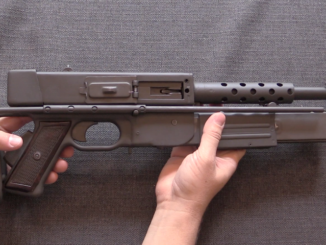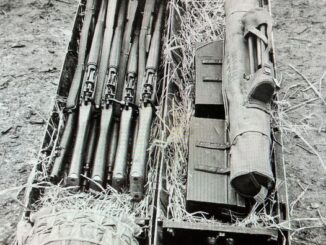Early in World War One, a small number (less than 200) Berthier rifle and cavalry carbines were adapted to use Chauchat magazines for aerial use. They were employed as defensive arms in observation balloons and as survival rifles in powered aircraft – applications where the larger capacity was of specific use, and the need to reload or carry extra ammunition was less important. Only a few exist today in museums and private collections, and the owners of Galerie de Mars in Paris were generous enough to let me film this example from their private collection for you.
Related Articles

Submachine Guns
MAT 49: Iconic SMG of Algeria and Indochina
The MAT-49 was developed by France after World War Two to satisfy the need for a more modern submachine gun to replace the MAS-38. The military had come around to standardizing on the 9x19mm cartridge […]

Handgun
Gaulois Palm Pistol at RIA
The Gaulois (Gallic) was a compact squeeze-type palm pistol made by the Manufrance concern in St. Etienne in the 1890s. It held 5 rounds of 8mm ammunition (similar to the .32 Extra-Short used in other […]

Bolt Action Rifles
Operation CARPETBAGGER: French Resistance No4 Enfield
During 1944, the US and UK cooperatively ran a major effort to drop arms and equipment to French Resistance forces in preparation for the Allied landings in France. It began as Operation Carpetbagger with night […]

Very impressive piece of work. Not only, as Ian points out, is trigger guard with mag release a unique piece, so is the stock. I can imagine that this carbine would be more stable due to its weight and easy to support by hand.
The use by fixed-wing aircrews was probably primarily as an observer’s gun while in the air.
As stated, this was from the early stages of the war (mid to late 1915), before mounted machine guns with interrupter gears became common. As with the .455in British Colt Automatic with the extended magazine and the case catcher, this would have been used to convince a German Taube scout pilot to make a nuisance of himself somewhere else.
cheers
eon
I was half tempted to say “get a 12-gauge shotgun and let the Hun have both barrels in the face.”
That’s what they used originally – shotguns.
“12-gauge”
That was officially .707 inch and interestingly Chain Shot and INCENDIARY ammunition was available, see 1st and 4th drawing from top respectively:
https://sites.google.com/site/britmilammo/air-service-wwi-non-303-inch/-707-inch-12b
Very unusual shot. Where did you dig this out? You are a chief researcher by now 🙂
There was also the .303 Pomeroy bullet, which had a payload of 15 grains of dynamite.
‘Pomeroy’s wife reportedly filled the first five thousand bullets with dynamite by hand.’
https://en.wikipedia.org/wiki/Pomeroy_bullet
“(…)As with the .455in British Colt Automatic with the extended magazine and the case catcher, this would have been used to convince a German Taube scout pilot to make a nuisance of himself somewhere else.(…)”
This need some explanation: early aeroplanes have pathetic payload capabilities from modern point-of-view, so many would most probably refuse to become airborne after strapping machine gun complete with special mount, allowing its turning and ammunition.
“German Taube”
What is that? I never heard of this flavor of Taube.
Do you mean (choose exactly one):
Rumpler Taube
Jeannin Stahltaube
Gotha LE.1
Gotha LE.2
Gotha LE.3
Gotha LE.4
something else
Anyway, interestingly wing form of all Taube was inspired by Alsomitra macrocarpa and IIRC original intention was to make it tailless, but this proved not feasible with then-current technology available.
I’m certain eon referred to the Rumpler Taube. Let’s not be tempted to go bird hunting with express rifles…
More properly the Etrich Taube;
https://en.wikipedia.org/wiki/Etrich_Taube
First flown in 1910 and the primary scout/”fighter” aircraft of the German Army Flying Corps in 1914-15.
Also known by some fourteen other names (Rumpler Taube, Albatros Taube, etc.) because it was built by over a dozen manufacturers and used by ten air forces, including (with one example bought in 1913) the British RFC.
It didn’t last past 1915 because the rapid evolution of fighter aircraft technology made its shortcomings very apparent.
cheers
eon
Obscurely known aircraft from militaryfactory.com
Reminds me that a C.S.R.G. prototype autorifle with top mounted magazine was tried out on early aircraft.
Interesting work-around the 3-round clip. 16 rounds would be much better!
Apparently two North American pilots, Phil Rader and Dean Ivan Lamb, flying near-identical Curtis biplanes as mercenaries for the Carrancistas and the Villistas went all Wild West gunslinger meets those magnificent men in their flying machines and traded pistol shots over Mexico in 1913. Similar antics appeared in the Balkan Wars, while the first aerial bomb, a Danish Aasen hand grenade, had been lobbed from an Italian aircraft over a Libyan oasis in 1911… By 8 Sep 1914 Russian Pëtr Nestorov tried to sacrifice his Morane machine’s landing gear in a ramming attack on an Austro-Hungarian observation aircraft, killing the pilot, observer, and himself in this, the first “kamikaze” attack by aircraft.
By 5 Oct. 1914 Louis Quénault machine gunned the Luftstreitskräfte pilot Wilhelm Schlichting, flying an Aviatik. The observer Fritz von Zangen died in the subsequent crash over Reims. Hotchkiss machine gun in a pusher Voisin III biplane flown by Sgt. Joseph Frantz thus scored the first air-to-air shoot-down of an enemy aircraft.
“(…)Pëtr Nestorov(…)”
He has own query in english Wikipedia: https://en.wikipedia.org/wiki/Pyotr_Nesterov
He was first man to perform loop (or at least first to do that with presence of eye-witness), even though some then-current aviators deemed it impossible.
(Which show us that early years of air sail were year of experiments, when there of need to experimentally bust of some theories, which we would not even though might be true – for example COLONEL CHINN reports that some before Great War believed that it is impossible to build flyable twin-engine aeroplane)
Anyway, in Russian language loop maneuver is named after him: петля Нестерова
Balloon action challenge match when? We want to know how useful rifles shot from balloon baskets are!
It’s not authentic without hydrogen.
A bit confused, if the aircraft had light machine guns at the time, why the resistance to put machine guns like the Chauchat in Observation and other balloons?
The French Army ground units needed those guns badly! A few Chauchat guns might have gone into balloons but they were hardly getting any press coverage in hindsight!
I will have to follow you, the information you bring is very real, reflecting correctly and objectively, it is very useful for society to grow together.